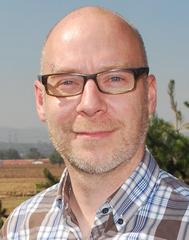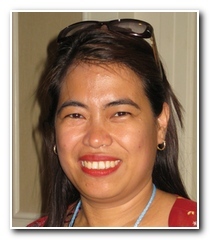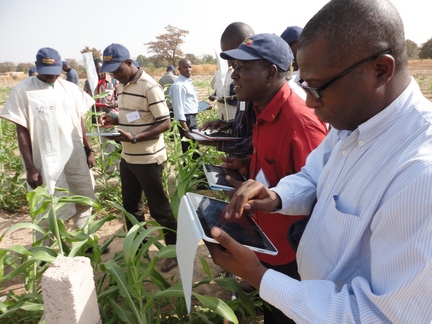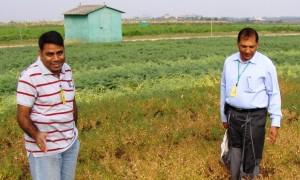Mark the man in the middle, and of the markers…
Today, we talk to Mark Sawkins (pictured), the ‘middleware’ man in our Integrated Breeding Platform (IBP) so to speak, seeing as he is the human ‘interface’ between crop breeders on the one hand, and the developers of our Integrated Breeding Platform (IBP) on the other hand. Mark is the ‘bridge’ that connects IBP users and IBP developers – a special position which gives him a privileged and fascinating perspective on both sides of the coin, with a dash of public–private sector pragmatic partnership thrown in too. Here’s more on Mark, in this dispatch from and on his special perch on the bench…
Bridge to bench, abuzz on BMS: A ‘tinker’ at Toulouse…
Mark Sawkins is always busy tinkering away on his Workbench at his base in Toulouse in southern France. It’s not your traditional wooden workbench, covered in sawdust, soil or splattering of paint. Nor is it one carpeted in documents lit by the warm glow of a computer monitor. In fact, the workbench Mark is working on is virtual, having no physical form and residing solely online, or on a user’s computer, once downloaded.
Known as the Breeding Management System (BMS) the Workbench, comprising software tools linked to a database for access to pedigree, phenotypic and genotypic data, has been developed by GCP’s Integrated Breeding Platform. The BMS has what a crop breeder would require to conduct an analysis of phenotypic and genotypic data generated as part of a crop-breeding or evaluation experiment, covering a broad spectrum of needs from conventional breeding to advanced molecular breeding applications. Version 2 of the Breeding Management System was released just last month.
… it [BMS] will be of most help to breeders both in the public and private sector in Africa and Asia who, up to now, have had little or no access to tools and data to allow them to shift gears in their breeding programme…The BMS has a lot of tools and all the foundational data necessary for a breeder’s routine day-to-day activities…The BMS is also anticipated to have enormous positive impact on food security in developing countries in the years ahead, enabling crop breeders to evaluate their progenies using the most sophisticated statistical methods available”
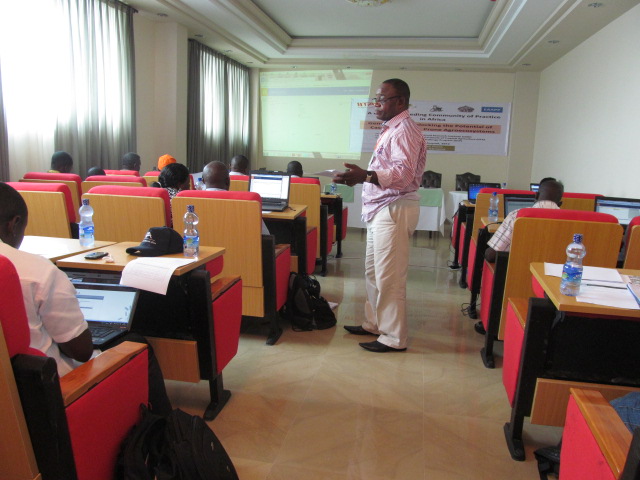
A hands-on BMS orientation workshop underway for breeders in Africa, held in Ethiopia in July 2013 under the auspices of the GCP-funded cassava breeding community of practice. Standing, Yemi Olojode, of Nigeria’s National Root Crops Research Institute (NRCRI), Umidike, who was one of the trainers.
Previously known as the Integrated Breeding Workflow System (IBWS), the BMS incorporates both statistical analysis tools and decision-support tools. The tools are assembled in a way that data can flow seamlessly from one application to the next in tandem with the various stages of the crop-breeding process. It allows the breeder to accurately collect, securely store and efficiently analyse and synthesise their data on a local private database, and also share, or compare, their data with other breeders via a central public crop database.
“The BMS has a lot of tools and all the foundational data necessary for a breeder’s routine day-to-day activities,” explains Mark, a plant geneticist who joined IBP in 2011. “Any breeder can use it, but it will be of most help to breeders both in the public and private sector in Africa and Asia who, up to now, have had little or no access to tools and data to allow them to shift gears in their breeding programme, particularly in adopting modern breeding practices, including the use of molecular markers.”
The BMS is also anticipated to have enormous positive impact on food security in developing countries in the years ahead, enabling crop breeders to evaluate their progenies using the most sophisticated statistical methods available, and make selections on which lines to advance to the next phase of development in the progression towards more productive and resilient crop varieties.
Phenotyping and field trials are becoming the most expensive part of the breeding process… The biggest hurdle in the public sector in the past was the massive investment required to set up genotyping laboratory facilities… outsourcing, we believe, will help convince breeders to consider integrating molecular techniques into their breeding programmes”
Why integrated breeding?
For almost 30 years, the private sector has been implementing molecular-breeding approaches in developing more productive and resilient crops. These approaches allow breeders to select for plant characteristics (traits) early in the breeding process and then test whether a plant has the targeted trait, which they cannot visually identify.
“Phenotyping and field trials are becoming the most expensive part of the breeding process,” says Mark. “Using molecular markers is a way to reduce the investment in that process. By using markers, early in the development of a given crop line, you can reduce the number of plants you need to grow and test, reducing the time and cost associated with field trials.”
Mark hopes that the Workbench will in time enable breeders, in under-resourced public breeding institutes to access some of the leading molecular-marker databases, and make use of the markers therein for the desired traits they are breeding for, along with technical support from molecular breeders to guide them in making their breeding decisions.
“The biggest hurdle in the public sector in the past was the massive investment required to set up genotyping laboratory facilities,” explains Mark “but now there are plenty of professional service providers that people can send their samples to and get back good results at a very reasonable cost. This time- and cost-saving reality of outsourcing, we believe, will help convince breeders to consider integrating molecular techniques into their breeding programmes.”
We are currently conducting a three-year course to train scientists from national programmes in West and Central Africa, East and Southern Africa and South and Southeast Asia, who we hope will promote and support the adoption of modern breeding in their institutes and countries.”

An Integrated Breeding Multiyear Course (IB-MYC) training course in session in April 2013 for the West and Central Africa group. Clarissa Pimentel, IBP’s Data Manager/Training Specialist, at the front, giving trainees tricks and tips on using FieldLab on the electronic tablet for field data collection.
Running with champions
Mark knows that giving breeders the tools and means to integrate molecular breeding into their programmes is one thing. To actually have them adopt them is another. But he has a plan.
In keeping with the core mission of GCP, which is to build sustainable capacity in developing-country breeding programmes, Mark proposes to recruit and train selected breeders in molecular-breeding techniques and set them up as champions and advocates for their particular crop or region.
Marker implementation methods can be varied but the tools required need to help the breeder make a quick informed decision on what to take forward to the next generation: What plants need to be crossed? Which plants should be kept and which ones discarded? The decision-support tools provided by the IB Workbench will help the breeder make these decisions.
“We are currently conducting a three-year course to train scientists from national programmes in West and Central Africa, East and Southern Africa and South and Southeast Asia, who we hope will promote and support the adoption of modern breeding in their institutes and countries,” Mark enthusiastically explains. The three-year training programme is known as the Integrated Breeding Multiyear Course (IB–MYC). Mark continues, “We believe that people will be more willing to listen to someone who is right there on the ground, whom they know and trust and can easily get in contact with if they need help.”
While the champions concept is still in its infancy, Mark believes it has real merit but must overcome two major barriers – time and confidence. “Identifying the champions won’t be hard,” he observes, “What will be hard is getting them to add this extra task to their already busy agenda. It will require buy-in from management at the institutional level to enable the champions to carry out their mission. It will also be individually hard for each champion, who will only be successful when they have the confidence in their own integrated breeding and extension skills. This confidence would be the thing that would really help sell the message.”
Engaging the private sector
Mark oversees the design, testing and deployment of the system that underpins the BMS, ensuring that both the system and the tools embedded in it are easy to use and meet the needs and expectations of the breeders. However, he and his team have had some trouble getting feedback on the system from the breeders it is intended for, due to their inexperience with such tools and systems. That is why he has called on his private-sector contacts, developed when he was at Syngenta where he worked for five years prior to his current assignment.
“We hope to show them what we’ve been doing in IBP with the Workbench, and hopefully get some private-sector buy-in and see how they can help us – not in developing tools, but with feedback on functionality and usability of the tools we are developing,” he explains. “We don’t have a core set of breeders who are routinely using markers in their breeding programme amongst the partners we are working with on the IBP project. So we are tapping into the private sector which has teams of molecular breeders who are more familiar with the types of breeding workflows and tools we are developing. We’re hoping that we can take advantage of their knowledge and experience to get some really useful feedback, which we will use to improve the usability and effectiveness of our tools.”
To maximise adoption and use, GCP has been actively engaged in extensive capacity building, and this will be reinforced with a comprehensive awareness-creation and communication effort immediately before and after a projected mid-year release of a newer BMS version incorporating the all-essential user feedback. The impact of the analytical pipeline in developing countries will be particularly enhanced with the availability of efficient user support services, which Mark will be overseeing.
Access the Breeding Management System (no-cost registration required)
More information
VIDEO: IBP’s comparative advantage for developed countries, while also relevant for developed countries.
SLIDES: IBP’s Breeding Management System
- Introducing the Integrated Breeding Platform – Brief | Blog | Podcast
- BLOGPOSTS:
- Integrated Breeding Multiyear Course (IB–MYC) – Brief | Podcast
- BOOK:Drought phentoyping in crops: from theory to practice







